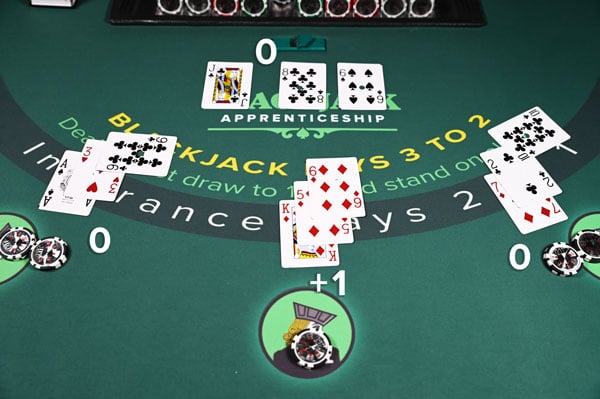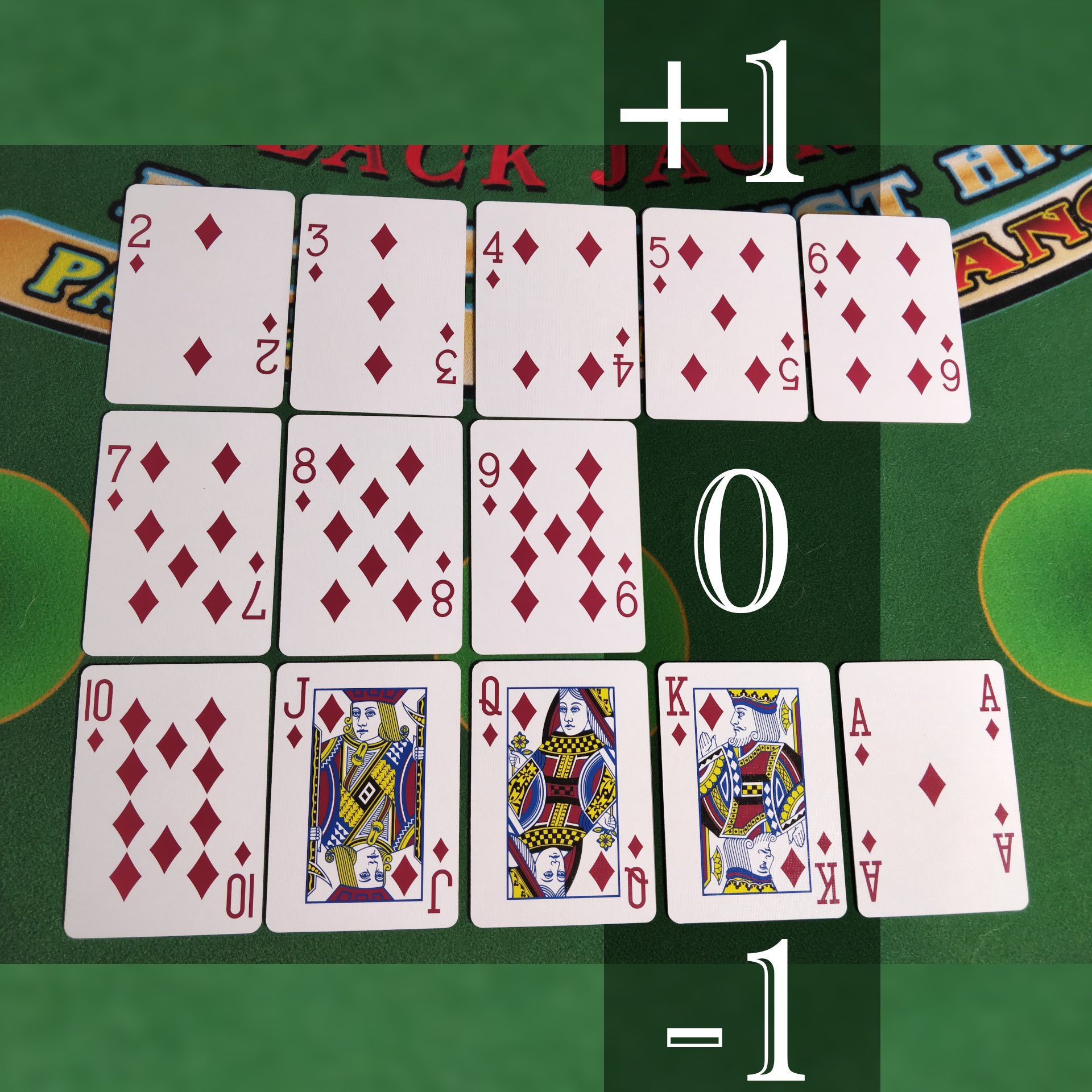How Do You Count Cards
Blackjack card counting requires a great deal of skill. After all, it’s an advantage gambling method that can provide an edge over the house.
Counting Cards Can Be Broken Into 4 Steps: Step 1: Assign A Value To Every Card. With Hi-Lo, the most common card counting system, the card values are as follows: Step 2: The Running Count. Step 3: Calculate A “True Count” Or Count Per Deck. Step 4: Change Your Bets As The True Count. My advice is, un most decks you won't have thaaat many foretell cards, so do a specific analysis for each specific deck. However, if you want a rule of thumb, sometimes I count them as half a 2-drop and half a (their full cost)-drop.
Therefore, most blackjack players think that counting cards is all about the skill. They believe that if they’re good enough, they’ll make profits no matter what.
This belief is true to some degree. However, one also needs a large bankroll to guarantee profits.
The following guide covers why you need significant money to make it as a counter. It also discusses how to determine the right amount of funds for when you are counting cards.
Most Card Counters Don’t Start With Enough Money
The average card counter doesn’t make it very far. They quickly flame out due to one or more reasons.
Here are some common reasons for why most card counters fail:

- Not skilled enough
- Not able to keep up with the dealer’s speed when counting
- Getting easily distracted by the casino environment
- Not knowing when to increase and lower bets
All of these are crucial problems that can derail a card counter before they even get started. But as you’ll notice, bankroll management isn’t listed among the above reasons.
Of course, nothing is stopping you from embarking on a card counting journey with $250. As you’ll find out later, though, $250 doesn’t provide much of a safety net.

Volatility – Crushing Card Counters Since the 1960s
People have been successfully and unsuccessfully counting cards since 1961. This is the year when Edward Thorp dropped his famous book Beat the Dealer, which taught numerous gamblers how to count cards.
Of course, most early APs didn’t make it very far. They might have picked up on Thorp’s counting advice, but they didn’t know much about volatility.
The latter is crushing to any underfunded card counter. Most APs only gain between a 1% and 1.5% advantage through counting.
A 1% edge is enough to make long-term profits with large bets. However, it isn’t a big enough advantage to guarantee profits every night.
You may experience really hot nights and win big some days. On others, though, you’ll lose to the casino even when doing everything right.
Again, the 1% advantage provides enough of an edge to win. But it also leaves you quite vulnerable to volatility.
You Need Enough Money to Properly Spread Bets
Casinos force you to wait until the beginning of a shoe before playing real money blackjack. They indicate this with signs on tables that read, “No mid-shoe entry.”
Therefore, you have no advantage upon first sitting down to a table and playing. You must count cards until verifying that a deck is rich in 10-value cards and aces (i.e. a positive count).
Once the count becomes positive, you want to increase your wagers to capitalize. This act of “bet spreading” is where you make profits.
Here’s an example on how to properly spread bets:
- A table features a $10 minimum bet.
- You increase your wager to $25 with a +1 count.
- You increase your bet to $50 with a +2 count.
- You increase your wager to $75 with a +3 count.
- You increase your bet to $100 with a +4 count or higher.
Once you start risking $50 or more per hand, you’re essentially playing high-stakes blackjack. At this point, you need significant money to bet $50, $75, or $100 on every hand.
You can’t do this for any sustainable amount of time with $500 or less. Instead, you need enough funds to comfortable bet up to $100 no matter if things are or aren’t going your way.
Guidelines on How Much Money You’ll Need to Count Cards
You can take one of two main approaches to card counting:
In the first case, you don’t need as much money to get started. After all, you’re the only one placing bets and taking profits.
You should be able to comfortably count cards with a $7,000 or $8,000 casino bankroll. Of course, having more than this is even better.
As for counting with a team, you need both “spotters” and a “big player.” Spotters spread out to different tables and count cards.
However, a spotter never raises bets, meaning they’re always facing a house edge. The spotter’s main role is to signal the big player (BP) when the deck is hot.
A BP can then sit down and immediately start placing big bets. In this manner, they never attract suspicion from casino staff members for bet spreading. They simply look like a high roller who’s benefiting from good fortune.

With spotters and a BP, card counting teams need additional starting capital. For this reason, a team should begin with anywhere from $18,000 to $23,000.
Calculating a More Specific Casino Bankroll
You can likely get started with little trouble when using the aforementioned general guidelines. However, you might also want to develop a plan that’s specifically tailored to you.
Here’s a generic example on getting started with calculating your bankroll:
- You count for around 300 hands per night (approx. three hours).
- Your average bet size is $40 when including the minimum wager and bet spreading.
- 300 x 40 = $12,000 in total wagers
- You hold a 1.5% edge.
- 12,000 x 0.015 = $180 theoretical profit per night
As seen in this example, you’ll bet $12k on average during each outing. You stand no chance of losing all $12k in a single night.
You’ll probably never lose 50% ($6k) of this amount either. However, you might lose up to 10% or more of your bets during a really bad night.
Using the above example, losing 10% of these bets means shredding $1,200 of your bankroll in one day. Assuming you go with the $7k or $8k general requirement, though, you can handle terrible nights.
The key is that you have enough money to get through the rough points and eventually make profits. You have the edge; you just need enough cushion to absorb losing nights and soldier on.
Gambling Cost Considerations
Your expenses likely won’t stop at just blackjack bets. You may also need money for traveling and food.
Assuming you choose to become a professional gambler, you’ll undoubtedly need to travel at some point. The longer you count cards, you will eventually be banned from one or more casinos.
However, you can prevent or at least minimize the amount of times you get banned by moving around. For instance, you may count in Las Vegas for one month, Atlantic City for another month, then finish the trip in Mississippi.
Your goal should be to move around and count cards as cheaply as possible. You can stay in cheaper hotels and eat at reasonably-priced restaurants. Other expenses will crop up as well, such as entertainment, fuel, and clothes.
Of course, you might not have many additional expenses at all when only counting locally. The downside to this, though, is that you stand a bigger chance of getting banned.
Casinos will be better able to recognize you in this case. Assuming you’re really serious about card counting, then you’ll want to consider traveling rather than staying in one spot.
Get Serious About Counting Cards Today
Counting cards can be as cheap or expensive as you want it to be. You can always walk into the casino with a few hundred dollars and hope for the best.
If you want a real shot at winning serious profits, though, then you should bring more money rather than less.
As covered earlier, $7k to $8k is adequate for a solo counter. A team, meanwhile, should have between $18k and $23k.
You can always use variables from your own counting experiences to get a more-concrete solution on your bankroll. You may need more or less money based on your bet sizes and how many hands you play. Please reference the earlier example if you need help getting started in this area.
You’re probably aware that you can count cards in blackjack and win money. Gamblers have been beating blackjack for decades through card counting.
Easiest Card Counting Systems
However, baccarat card counting is far more low profile. The reason why is because it doesn’t generate many profits.
But you can make a fair amount of money when counting with a certain baccarat side bet. I’ll discuss more on how you can use this method later. First, though, I’d like to discuss why regular baccarat counting doesn’t result in big winnings.
The Problem With Standard Baccarat Card Counting
Some gamblers are shocked upon finding out that blackjack isn’t the only game that can be beaten through card counting. You can also earn long-term profits by counting baccarat games as well.
Of course, you need to learn the proper strategy before you’re able to make profits. If you put in the dedication, though, you can beat baccarat. However, there’s a big catch involved. You’re not going to make much money at all!
Maybe you still wouldn’t mind counting for fun once and a while if it were easy. However, counting this game is just as difficult as doing so with blackjack.
In short, you’re wasting time by counting cards in baccarat. You might as well just sit back, relax, and place the banker bet (1.06% house edge) every time.
Welcome to the Dragon Side Bet
You can see that baccarat isn’t a profitable game for advantage players (APs) under normal circumstances. No respectable AP will waste their time with earning $0.70 or less.
However, the Dragon side bet offers an interesting opportunity to make larger profits. I’ll discuss how you can count with the Dragon wager later.
How Do You Count Cards In Gin Rummy
First, though, I’d like to cover more on how this bet works. It features the following rules:
- You wager on whether the banker or player will beat the other side by a certain point margin.
- The banker or player must win with a “natural” (eight or nine on first two cards).
- Bets on larger margins of victory deliver bigger payouts.
The common pay table for both the player and banker side is as follows:
- Win by 9 = 30:1 payout
- Win by 8 = 10:1
- Win by 7 = 6:1
- Win by 6 = 4:1
- Win by 5 = 2:1
- Win by 4 = 1:1
- Anything else = Loss
Counting Cards With the Dragon Side Bet
You can see how the Dragon side wager works. Now, I’ll cover how it can help you make profits with card counting.
The first thing to realize about baccarat is that most casinos allow very deep deck penetration. In most cases, the dealer makes it almost to the end of an eight-deck shoe.
This deck penetration is significant when considering that you stand to win more money as a counter upon seeing additional cards. After all, your count will be more accurate towards the end of a shoe.
Casinos don’t allow this much penetration in order to stop blackjack card counters. But they have no problem doing so with baccarat when considering that normal counting methods don’t result in much profit.
However, this extra deck penetration can definitely help you win with side bets. You just need to know how to do so with the Dragon wager.

As mentioned above, player and banker dragon bets carry 2.65% and 9.37% house advantages, respectively. Therefore, you want to bet on the player’s side when counting.
Dr. Eliot Jacobson, a renowned gambling mathematician, has run the numbers on counting the Dragon bet. He notes that you want a shoe that’s rich in sevens, eights, and nines.
These cards increase the chances of your chosen Dragon side getting a natural. They should be assigned a point value of -1 when they come out of the shoe (bad for you).
Meanwhile, twos and threes are the worst cards for helping form naturals. Therefore, you want as few of these cards as possible. They should draw a point value of +1 when they’re dealt.
As with blackjack card counting, you’re looking for a positive count before raising bets. Upon determining a positive count, you should raise your wagers to capitalize.
What Kind of Edge Can You Gain With This AP Strategy?
The nice thing about counting cards in baccarat is that you don’t need to worry about much, if any, heat from the casino. Gambling establishments will let you count this game all day.
That said, you have a decent chance of walking away with profits at the end of the day when everything goes right. However, you shouldn’t expect to get rich with this strategy.
But this profit rate assumes that you get optimal deck penetration, where the dealer only leaves 14 cards undealt out of an eight-deck shoe.

Assuming the dealer places the cut card further up, then your profits drop. Here’s how much you can look forward to earning based on where the cut card is placed:
- Cut card at 14 cards = $9.09 per hour
- Cut card at 26 cards = $6.75
- Cut card at 52 cards = $3.99
- Cut card at 104 cards = $1.50
Is Counting Cards With the Dragon Bet Worthwhile?
Counting the Dragon bet offers around the same profits as you’d earn when playing full-pay Deuces Wild with a quarter denomination. The latter delivers between $7 and $9 per hour under ideal conditions.
As an AP, you can earn up to a maximum of $9 hourly with the Dragon bet. Therefore, you can look forward to a decent profit when considering that casino games normally take money from you in the long run.
Counting Cards In Casinos
But is it worthwhile to actually go through all the trouble to make $9 each hour? I certainly wouldn’t say so.
How Do You Count Cards In Blackjack Casinos
You can make this same hourly wage with much simpler jobs. Dishwashers and convenience store workers earn this same amount. Why then, would you want to do something that’s much riskier just to make the same amount with a less stressful job?
The only reasonable answer is if you view winning at baccarat as a challenge and want to profit off your gambling hobby. In this case, making $9 each hour in the casino isn’t so bad.
However, you certainly shouldn’t quit your day job to capitalize on the Dragon bet. This opportunity just doesn’t offer enough money to make it worth your time.
Conclusion
Regular baccarat card counting is a complete wash. It calls on you to diligently count cards in pursuit of making pennies each hour.
How Do You Count Cards In Spades
But standard baccarat counting isn’t the only way to make money with this game. You can earn bigger profits through the Dragon side bet.
How Do You Count Cards In Cribbage
When you count and bet on the Dragon wager in the right manner, you can make upwards of $9 per hour. Much of your winnings, though, depend upon where the cut card is placed.
How Do You Count Cards In Texas Holdem
That said, you can make $9 every hour with ideal deck penetration. But you probably still don’t find this amount to be worth the trouble of counting cards in baccarat.